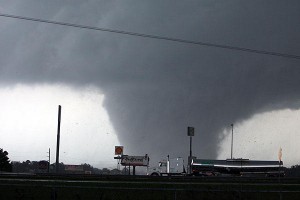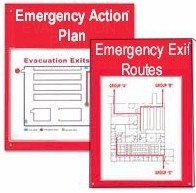 Preparedness
Preparedness
Preparedness involves a continuous process of planning, equipping, training and exercising. Planning for tornadoes requires identifying a place to take shelter, being familiar with and monitoring your community’s warning system, and establishing procedures to account for individuals in the building. Employers may need to obtain additional equipment and/or resources (e.g. Emergency Supply Kits) identified in the plan. In addition, workers need to be trained and plans need to be practiced to ensure that personnel are familiar with what to do in the event of a tornado.
Planning
Identifying Shelter Locations
- An underground area, such as a basement or storm cellar, provides the best protection from a tornado. If an underground shelter is unavailable, consider the following:
- Seek a small interior room or hallway on the lowest floor possible
- Stay away from doors, windows, and outside walls
- Stay in the center of the room, and avoid corners because they attract debris
- Rooms constructed with reinforced concrete, brick or block with no windows and a heavy concrete floor or roof system overhead
- Avoid auditoriums, cafeterias and gymnasiums that have flat, wide-span roofs.
- Personnel should also be aware of what to do if caught outdoors when a tornado is threatening. Seek shelter in a basement or a sturdy building. If one is not within walking distance, try to drive in a vehicle, using a seat belt, to the nearest shelter. If flying debris is encountered while in a vehicle, there are two options: 1) staying in the vehicle with the seat belt on, keeping your head below the windows and covering it with your hands or a blanket, 2) if there is an area which is noticeable lower than the roadway, lie in that area and cover your head with your hands.
Accountability procedures
The following steps are recommended to help ensure the safety of personnel if a tornado occurs:
- Warning Systems
- Tornado Watch – Tornadoes are likely to occur in the watch area. Be ready to act quickly and take shelter, and check supply kits. Monitor radio and television stations for more information.
- Tornado Warning – Imminent threat – A tornado has been sighted in the area or has been indicated by radar. Take shelter immediately.
- Your local emergency management office can provide information about your community’s tornado warning system.
- Develop a system for knowing who is in the building in the event of an emergency
- Establish an alarm system to warn workers
- Test systems frequently
- Develop plans to communicate warnings to personnel with disabilities or who do not speak English
- Account for workers, visitors, and customers as they arrive in the shelter
- Use a prepared roster or checklist
- Take a head count
- Assign specific duties to workers in advance; create checklists for each specific responsibility. Designate and train workers alternates in case the assigned person is not there or is injured
via Tornado Preparedness and Response – Preparedness.
 An emergency action plan (EAP) is usually a written document required by particular OSHA standards. For smaller organizations, the plan does not need to be written and may be communicated orally if there are 10 or fewer employees [29 CFR 1910.38(b)]. The purpose of an EAP is to facilitate and organize employer and employee actions during workplace emergencies. The elements of the plan must include, but are not limited to:
An emergency action plan (EAP) is usually a written document required by particular OSHA standards. For smaller organizations, the plan does not need to be written and may be communicated orally if there are 10 or fewer employees [29 CFR 1910.38(b)]. The purpose of an EAP is to facilitate and organize employer and employee actions during workplace emergencies. The elements of the plan must include, but are not limited to:



